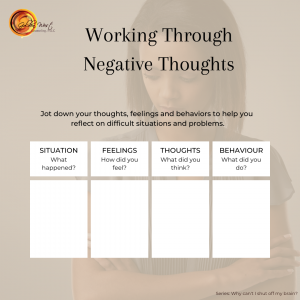Does it feel as if your brain just never turns off? Is it difficult to relax because you’re overthinking and worrying about this or that?
Do you find yourself laying in bed at 3am, wondering “Why can’t I fall asleep?” or attempting to soothe your mind by meditating for a few minutes?
A busy or racing mind is a struggle for many of us, and it could have many different causes. There are some common factors that may make it feel as if your brain feels like a bouncing ball.
Stress: Stress is the top reason when you can’t seem to calm your thoughts. Stress increases cortisol in your body, which helps you to stay alert. This also means that your brain wants to stay alert, even in inopportune times.
The release of cortisol can also create symptoms of anxiety and when cortisol is high enough it can keep you from relaxing or sleeping. Common physical symptoms such as increased pulse, heart palpitations, and higher body temperature are common.
Life events that are stressful and can increase cortisol release levels:
- Change in jobs
- Moving
- Demanding work or school
- Job promotion
- Conflict with another person
- A calendar that does not allow for downtime
- Wedding planning. While joyful, planning a wedding can be stressful
- Being a caregiver
- Struggles juggling a large amount of responsibilities
- Grief and bereavement
- Health concerns
Negative Thoughts: We all have them! Sometimes they pop up like an uninvited guest. Sometimes they hang around taking up space in your mind for hours. Negative thoughts are thoughts that come into our mind automatically when we are feeling anxious, depressed, frustrated, angry; anytime we have a negative emotion.

There are different types of negative thoughts, such as worry. Worry is connected to fear, in that thinking something bad will happen in the future. Most struggles with anxiety have some kind of worry associated with it. For example, a negative thought of “I may lose my job and if I lose my job I may then lose my home.”
Another type negative thought is a negative statement to one’s self, other people or larger society/community. For example, “I’m not good enough.” This statement is not a worry, but rather a statement about one’s self. Oftentimes those struggling with depression have these thoughts. Cognitive skills can work on managing these thoughts and worries.
Cognitive Distortions in Thinking
Anxiety can cause us to assume the worst. There are several different types of anxiety producing thoughts. As counselors we call these Cognitive Distortions. Understanding cognitive distortions is an important part in understanding our thoughts and finding ways to work on them using cognitive behavioral therapy (CBT) skills. When we can understand some common patterns in faulty thinking, it becomes easier to notice our patterns, thus easier to implement changes to our thinking.
Cognitive Distortions are unhelpful thoughts that keep anxiety alive in our minds:
- Perfectionism: The belief that all mistakes are bad and are to be avoided. We may even attempt to control situations and circumstances to fit what we think is “right.”
- Jumping to Conclusions: Creating conclusions about the meaning of a situation with little or no evidence. “I don’t have a good job, so she’s not going to want to date me.”
- Personalization: Believing that you are responsible for events/situations that are out of your control. “I always upset him. He would do better if I did more for him.”
- Overestimating: Creating interpretations about a situation from a single or few events. “I felt out of place at the party. I don’t belong to any community”
- Catastrophizing: Seeing the worst case scenario of a situation. “I bombed the test. I will never graduate college.”
- Fortune Telling: Having the expectation that a situation’s outcome will turn out negatively without adequate evidence. “I didn’t respond quickly to their questions in the interview. I won’t get the promotion.”
- Should Statements: Believing that things “should” be a certain way. “I should always anticipate someone’s else’s response”
- All or nothing thinking: Having absolute thinking, such as “never”, “always”, or “every.” “I always misread situations, I will never be seen as a professional.”
Use these steps to get back to a relaxed mind:
Step 1: Notice that you are in “thinking mode”
Step 2: Ask yourself: What am I physically feeling in my body right now? Is my back tight, are my shoulders tense, or perhaps there’s a headache. Simply acknowledge that these sensations are present
Step 3: Ask yourself: What feelings am I experiencing? Do I feel uncomfortable, overwhelmed, or anxious? Using an emotional wheel can be helpful in these moments. Consider saving this one to your phone so it’s always with you!
Step 4: Ask yourself: What thoughts are going through your mind? You may have many. Take a few moments to jot them down, if necessary.
More Mental Decluttering Habits: Teach your mind some New Tricks
Deep Breathing
Deep breathing helps you feel connected to your body, shifts your attention away from your worry, and quiets the inner dialog in your mind, thus triggering the “relaxation response.” “The relaxation response is a physical state of deep rest that changes the physical and emotional responses to stress… and the opposite of the fight or flight response” (The Relaxation Response, Herbert Benson).
Square Breathing
- Begin by slowly exhaling deeply
- Gently inhale through your nose and slowly count to 4
- Pause and hold your breath for a count of 4
- Gently exhale through your mouth for a count of 4
- Pause and hold your breath for a count of 4
- Repeat
Reframe Negative Thoughts
It may feel rather natural or automatic to allow your mind to wander into worry. By doing this, you have inadvertently reinforced negative thought patterns by not challenging your thoughts. By building a reframing habit you have the power to recognize Cognitive Distortions and change them.
Strategy 1: Name That Thought
Mentally acknowledge that your thoughts are nothing more than a thought. Not Reality. Try “I’m having the thought that I will never accomplish this,” rather “This will never get done.” This reinforces your brain that the thought is not fact but rather a thought.
Strategy 2: Schedule the worry
When you catch yourself in a negative thought, simply tell your thought that it’s scheduled time is at 6pm that evening (you choose the day/time). Do this every time you notice the thought throughout the day. When 6pm rolls around (or the time of your choice), allow yourself to think or journal about your negative thoughts for up to 20 minutes. Sitting with your thoughts for longer periods of time can increase the likelihood of reaching rumination. Once the 20 minutes is up, allow yourself to distract your mind by doing a different activity.
Strategy 3: Intentionally Distracting Yourself
Break the cycle using intentional distractions. Do something that will occupy your mind for a period of time. Divulge yourself in a project that involves focus and brainpower.
Challenge the Thought and Replace it.
Have you noticed that many of your thoughts are a bit… let’s say… exaggerated? They are not the truth, or at the least, not the entire truth. You may think, “I’m an idiot, I will never get it right.” In the moment, you certainly feel like a loser, yet if you were to examine the thought, you’ll recognize that it’s not truthful. You have done many things well and have been successful in many instances.
Rather than allowing “all or nothing” thinking to live rent free in your mind, challenge these negative thoughts! This simply means having a concrete example that challenges the thought by reminding it with positive moments or previous “wins”.
For example, let’s say you are an individual contributor at a tech company who receives a negative yearly review. Your first thought may be, “I’m terrible at my job, everyone hates me, and I’m going to be placed on a PIP.” However, if you take the time to look at the reviews, you may recognize that the majority of your colleagues enjoy working with you. They may have some requests to continue a positive working relationship.
Using positive reminders may feel awkward at first, but over time you will train your brain to interrupt the cycles of negative thoughts. This habit helps to take control of your reality and puts wrenches in front of the never ending cycle of self sabotaging beliefs.
Seeking Professional Help
Sometimes doing it yourself efforts aren’t enough. If racing thoughts are still interfering with your life, consider giving us a call and scheduling a complimentary consultation with one of our Licensed Mental Health Counselors.


